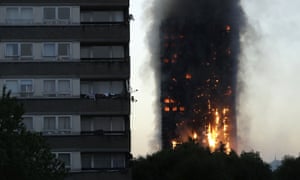Early next year, a rectangle of earth abutting the north wall of St Clement’s church and facing the blackened hulk of Grenfell Tower will be cleared. Shrubs will be planted and benches installed to create a garden of peace and healing, a place for reflection and remembrance.
A few minutes walk away, at the Notting Hill Methodist church, where the tower looms through tall windows, a choir composed of survivors and bereaved relatives will assemble in January. The therapeutic value of music will be reinforced by a director with experience of choirs of homeless people.
At the Al-Manaar mosque and community centre, dozens of children from the local community took part in a “winter camp” of activities, run jointly with the West London Synagogue, in the run up to Christmas. In the new year, the mosque will begin a detailed evaluation of its response to the fire in order to be ready to help other communities in the future.

For the past six months, these three faith organisations, along with others in North Kensington, have been at the heart of the community affected by the devastating Grenfell Tower fire, in which 71 people died and hundreds of families were made homeless.
“I still feel as though I’m muddling through,” said Mike Long, minister of the Methodist church. “We had no ready-made action plan to take off the shelf for this. At times there’s still confusion and frustration. But I’ve learnt hugely.”
Alan Everett, the vicar of St Clement’s, said that in the immediate aftermath of the 14 June fire, “we were just responding to things on a day-to-day basis and largely feeling overwhelmed. At times there was a sense of complete helplessness and total exhaustion.”
At the mosque, chief executive Abdurahman Sayed said: “Initially, when the fire broke out, we thought it would be a matter of a few hours – it would be brought under control and people would be saved. Then we thought, okay, this is going to take a few days.”
Then came the realisation that supporting the community in the aftermath of the fire would be the focus of the mosque’s work for the foreseeable future. “We have no luxury of choosing whether or not to be involved, it’s not an option. As a mosque, we cannot turn a blind eye when people need support,” said Sayed.
Now the faith organisations are looking ahead, with plans for next year including a “day of reflection” to share their experiences and learn lessons for the future. “The community can never get back to normal,” said Long. “But people talk about a ‘new normal’, the end of the chaos.”
Along with rehousing, a key to that is the shell of the tower being demolished, which is unlikely to happen before the end of 2018.
“Residents have the daily trauma of seeing the tower standing in their midst,” said Everett. “The psychological damage it’s inflicting on people on a daily basis is so extreme that for it to remain standing is unthinkable. It’s the first thing some people see when pulling up their kitchen blind in the morning; children are walking past it every day on their way to school. It will be a massive relief when it comes down, and then we can take time to decide what to do with the site.”
On the night of the fire, Everett woke in the early hours when a colleague called to tell him of the unfolding disaster. The clergyman went to St Clement’s, switched on the lights and opened the doors. Soon people came: survivors, neighbours, emergency workers, volunteers.
Long had also been woken up. As he dressed, he put on his clerical collar for the first time for months. “I’ve never really liked wearing a dog collar, I’ve never been that comfortable with the established vicar role. I’ve been in many situations where I regard being a visible member of the church as a barrier. But here, since the fire, there has been a need for people to represent the community, so my wearing a collar every day now is very appropriate,” he said.
At the same time that Everett was turning on the church lights and Long was putting on his dog collar, Sayed was driving as fast as he legally could to North Kensington, which was lit up by the fire. By the time he reached the mosque, it was already filling up with volunteers and donations.
The next day, St Clement’s was asked to host the prime minister, Theresa May, during a visit to area to meet survivors and volunteers. “It was obvious from the sounds outside that there was intense hostility to the visit, but also there was an element of risk for the church, that we might become identified with a distrusted authority,” said Everett.
But, he added, it would be “unthinkable” for a place of worship to refuse the prime minister the opportunity to meet members of the community. “Faith communities have to be prepared to walk that line.”
All three faith leaders had similar qualms over hosting public meetings arranged over the summer by Grenfell Response, a body set up by Kensington and Chelsea council to provide information and advice in the aftermath of the fire. The meetings, held in the mosque and both churches, became a focal point for the community’s anger and frustration.
“Sometimes I wondered if the meetings did more damage than good,” said Long. “But what would have happened if those meetings hadn’t taken place? They were hugely depressing and hard to control, and people were consumed with anger, but it was important for the authorities to hear that anger.”
Simultaneously, a lot of work was going on, unseen, in the background. “If you did a time and motion study, you’d think what is that guy doing all day. It’s mostly chatting and being available,” said Long.
“A lot of it is about small conversations, to help people hear things they may not want to hear, or in ways that don’t involve a defensive response. So much of what we’ve heard has been polarised.”











